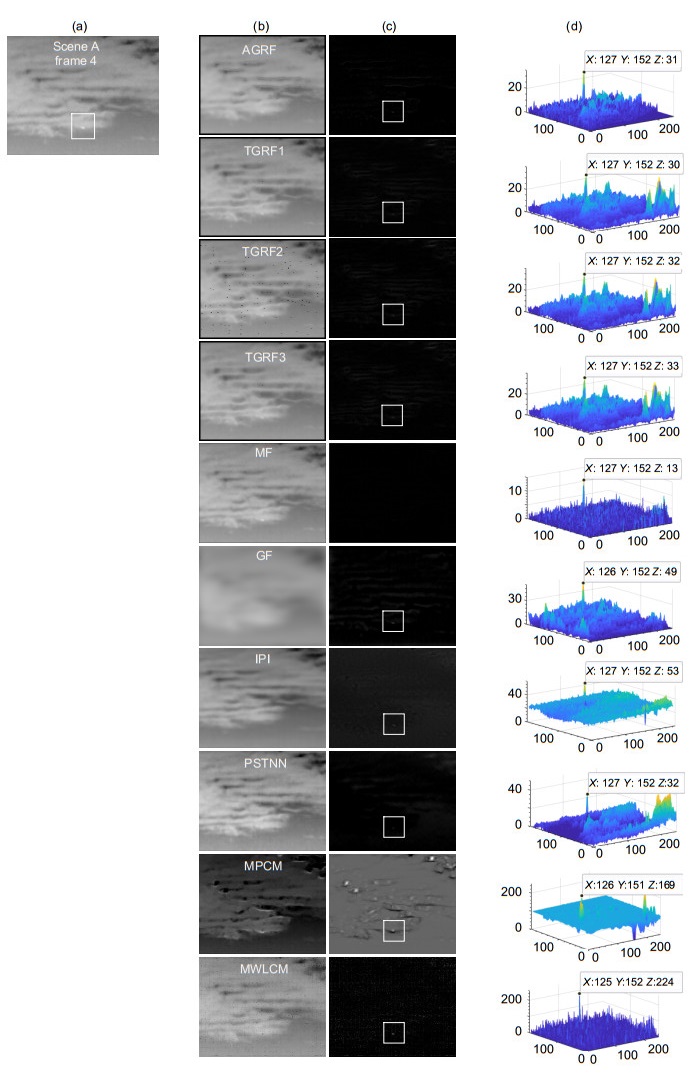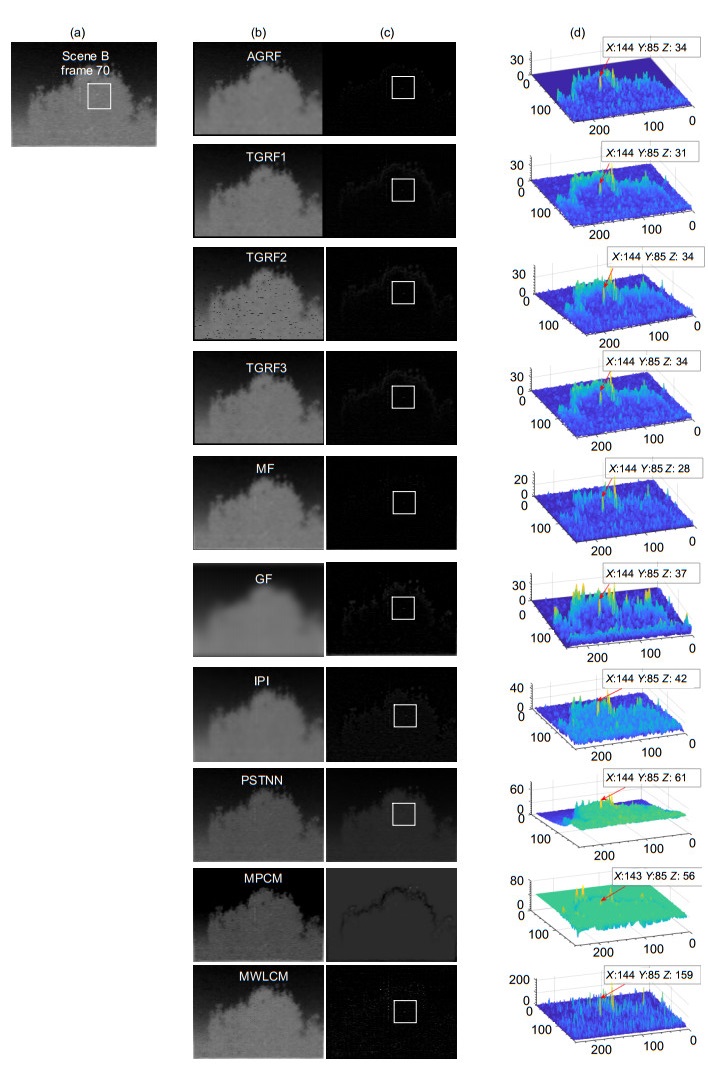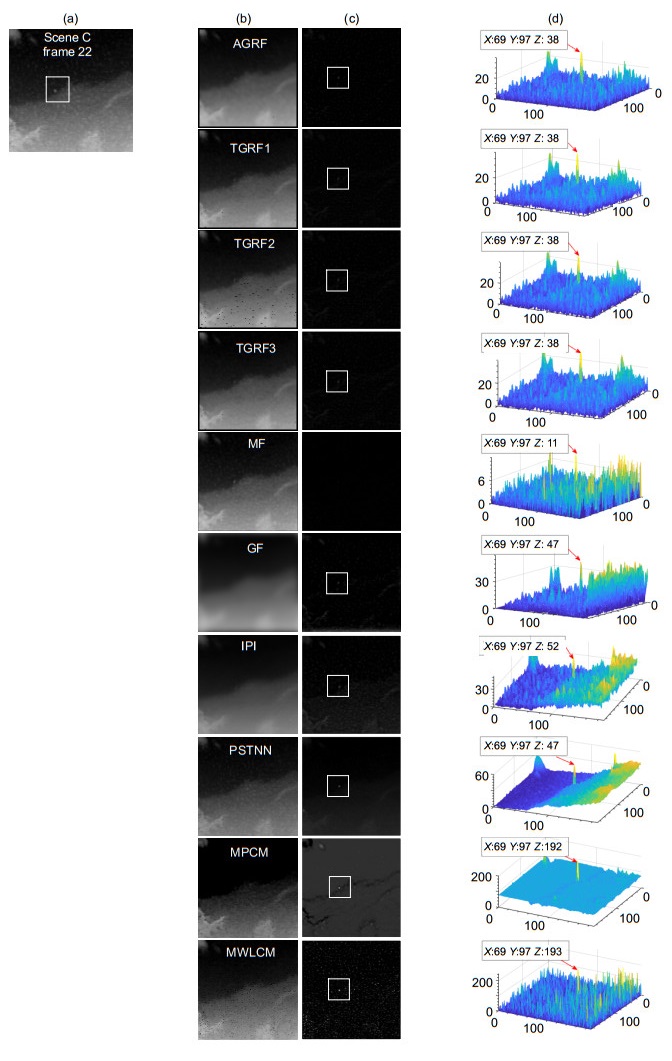Background suppression for infrared dim small target scene based on adaptive gradient reciprocal filtering
-
摘要
由于红外弱小目标尺度小、能量弱,所以抑制背景以增强目标使后期检测跟踪性能得到保障是关键的目标检测技术环节。为了提高梯度倒数滤波算法对杂波纹理的抑制能力,减少差分图像中残留纹理对目标的干扰,本文提出了自适应梯度倒数滤波算法(AGRF)。AGRF算法通过分析背景区域、杂波边缘纹理、目标的分布特性和统计数字特征来确定邻域像素间相关性的自适应联合判定阈值和自适应相关度系数函数,然后联合相关度系数函数和梯度倒数系数来确定自适应梯度倒数滤波器的元素值。实验结果表明,在具有相同目标增强性能的前提下,AGRF算法相比传统梯度倒数滤波算法对杂波边缘纹理的敏感度明显降低。相比九种对比算法,AGRF算法能够在背景抑制和目标增强这两者之间取得更好的性能平衡。

Abstract
Due to the small scale and weak energy of the infrared dim small target, the background must be suppressed to enhance the target in order to ensure the performance of detection and tracking of the target in the later stage. In order to improve the ability of gradient reciprocal filter to suppress the clutter texture and reduce the interference of the residual texture to the target in the difference image, an adaptive gradient reciprocal filtering algorithm (AGRF) is proposed in this paper. In the AGRF, the adaptive judgment threshold and the adaptive relevancy coefficient function of inter-pixel correlation in the local region are determined by analyzing the distribution characteristics and statistical numeral characteristic of the background region, clutter texture, and target. Then the element value of the adaptive gradient reciprocal filter is determined by combining the relevancy coefficient function and the gradient reciprocal function. Experimental results indicate that the sensitivity of the AGRF algorithm to the clutter texture is significantly lower than that of the traditional gradient reciprocal filtering algorithm under the premise of the same target enhancement performance. Compared with the other nine algorithms, the AGRF algorithm has better signal-to-noise ratio gain (SNRG) and background suppress factor (BSF).
-
Overview

Overview: Due to the small scale and weak energy of the infrared dim small target, the background must be suppressed to enhance the target in order to ensure the performance of detection and tracking of the target in the later stage. In order to improve the ability of gradient reciprocal filter to suppress the clutter texture and reduce the interference of the residual texture to the target in the difference image, an adaptive gradient reciprocal filtering algorithm (AGRF) is proposed in this paper. In the AGRF, the adaptive judgment threshold and the adaptive relevancy coefficient function of inter-pixel correlation in the local region are determined by analyzing the distribution characteristics and statistical numeral characteristic of the background region, clutter texture, and target. Then the element value of the adaptive gradient reciprocal filter is determined by combining the relevancy coefficient function and the gradient reciprocal function. Experimental results indicate that the sensitivity of the AGRF algorithm to the clutter texture is significantly lower than that of the traditional gradient reciprocal filtering algorithm under the premise of the same target enhancement performance. Compared with the other nine algorithms, the AGRF algorithm has better signal-to-noise ratio gain (SNRG) and background suppress factor (BSF).
Compared with the traditional gradient reciprocal filtering algorithm, the AGRF algorithm has the following characteristics: 1) The parameters are fully adaptive. The AGRF algorithm provides a new threshold determination method for the inter-pixel correlation, which realizes the adaptive determination of the threshold with the statistical features of the neighborhood pixels. A new correlation coefficient function is defined to improve the gating performance of the filter by its value nonlinear adaptive change with the correlation coefficient. 2) Compared with the traditional reciprocal gradient filtering algorithm, the AGRF algorithm can effectively suppress the background with better texture suppression. Compared with the traditional reciprocal gradient filtering algorithm, the parameters of the AGRF algorithm can be adjusted completely adaptively according to the statistical characteristics of image components with different distribution characteristics, so it can achieve better texture suppression performance.
-

-
表 1 场景A、B和C中目标的能量、速度和轨迹特征
Table 1. The energy, velocity, and trajectory characteristics of the targets
Scenes Total frames Sizes SNRin/dB Velocities/(pixels/frame) Trajectories Min Max Mean Min Max Mean A 30 256×200 1.9764 14.4036 9.1537 0 2.8284 1.2967 Complex curve trajectory B 164 245×175 0.8277 12.6054 7.8838 0 1.4142 0.2809 Linear trajectory C 56 196×196 0.0810 12.2177 7.3223 0 1.4142 0.5727 Reciprocating moves with
a complex trajectory表 2 AGRF和另外九种对比算法的参数值
Table 2. The parameters of the ten algorithms
Algorithms Parameters AGRF Structural element size: m×n, m=n=3 TGRF1 Structural element size: m×n, m=n=3, θ=10 [27] TGRF2 Structural element size: m×n, m=n=3, K=5, c=1 [28] TGRF3 Structural element size: m×n, m=n=3, K=2, c=2 [29] MF Structural element size: m×n, m=n=3 GF Bandwidth: B=5 IPI Patch size: 50×50, sliding step: 10, λ=(min(size(D)))-1/2, φ=10-7 [23] PSTNN Patch size: 40×40, sliding step: 40, λ=0.6×(max(size(D)))-1/2, φ=10-7 [26] MPCM Mask size:N=3, 5, 7, 9 [15] MWLCM Convolution mask size:D=3, Weighted mask size:W=3, 5 [16] 表 3 AGRF和另外九种对比算法的背景抑制效果
Table 3. The SNRG and BSF values of AGRF and the other nine algorithms
Scenes Algorithms SNRG/dB BSF Min Max Mean Min Max Mean A AGRF 1.4318 14.5467 8.5152 8.4074 10.1775 9.1212 TGRF1 0.1389 5.3168 3.2409 5.8432 6.4920 6.0675 TGRF2 0.3707 5.4119 3.2926 5.5092 6.1362 5.7112 TGRF3 0.2595 5.4322 3.2426 5.3443 5.9421 5.5412 MF -1.3206 7.8455 2.1052 2.9911 3.5830 3.1966 GF 0.5245 9.1417 3.9417 3.7368 4.3449 3.9863 IPI 1.0146 8.3615 3.6349 3.3556 6.1655 4.3638 PSTNN 1.4266 9.5410 4.3144 2.4219 4.4709 2.9881 MPCM -5.2338 10.4453 3.9401 1.8895 3.7153 2.6015 MWLCM 0.7277 12.1279 3.8269 1.7149 5.2469 3.4517 B AGRF -0.2955 3.5235 1.5316 18.3679 19.1034 18.7378 TGRF1 -0.9171 3.3898 1.5090 13.3689 13.6873 13.5670 TGRF2 -0.6594 3.0443 1.3981 12.1735 12.4756 12.3671 TGRF3 -1.0907 3.5175 1.4915 12.0277 12.3255 12.2187 MF -1.3828 3.1671 0.8868 5.5295 5.6620 5.5934 GF -6.9077 2.6916 0.7823 4.1608 4.2158 4.1826 IPI -1.3244 1.4968 0.0566 7.4858 18.0002 10.7508 PSTNN -0.6069 3.1282 0.0953 2.7764 4.0866 3.3782 MPCM -11.4079 0.8875 0.0321 11.4831 13.2417 12.1940 MWLCM -6.9957 2.4653 0.8712 4.5383 7.8829 6.0311 C AGRF 0.3587 10.2301 4.2088 18.6607 21.7150 19.8299 TGRF1 -0.4963 10.0609 3.7432 18.0908 20.7674 19.4282 TGRF2 -0.5165 9.8415 3.6595 16.4072 18.9794 17.6397 TGRF3 -0.4726 9.9181 3.6877 16.2585 18.7240 17.4669 MF -2.7098 6.3646 1.1974 10.4714 10.7958 10.6413 GF 0.1454 9.6489 4.1923 5.5057 5.6942 5.5993 IPI 0.1339 9.4985 3.2826 4.8423 6.7377 5.6288 PSTNN 0.3203 9.4696 4.1053 4.1923 5.2520 4.6491 MPCM 0.2853 9.0189 3.2278 4.9868 19.3601 11.5253 MWLCM -0.3660 8.9545 3.6217 3.9536 9.0515 6.0181 -
参考文献
[1] Garcia-Garcia B, Bouwmans T, Silva A J R. Background subtraction in real applications: challenges, current models and future directions[J]. Comput Sci Rev, 2020, 35: 100204. doi: 10.1016/j.cosrev.2019.100204
[2] Villar S A, Torcida S, Acosta G G. Median filtering: a new insight[J]. J Math Imaging Vis, 2017, 58(1): 130-146. doi: 10.1007/s10851-016-0694-0
[3] Sobral A, Vacavant A. A comprehensive review of background subtraction algorithms evaluated with synthetic and real videos[J]. Comput Vis Image Understand, 2014, 122: 4-21. doi: 10.1016/j.cviu.2013.12.005
[4] Bai X Z, Zhou F G. Infrared small target enhancement and detection based on modified top-hat transformations[J]. Comput Electr Eng, 2010, 36(6): 1193-1201. doi: 10.1016/j.compeleceng.2010.05.008
[5] Goyal K, Singhai J. Review of background subtraction methods using Gaussian mixture model for video surveillance systems[J]. Artif Intell Rev, 2018, 50(2): 241-259. doi: 10.1007/s10462-017-9542-x
[6] Dong X B, Huang X S, Zheng Y B, et al. Infrared dim and small target detecting and tracking method inspired by human visual system[J]. Infrared Phys Technol, 2014, 62: 100-109. doi: 10.1016/j.infrared.2013.11.007
[7] Bae T W, Kim Y C, Ahn S H, et al. An efficient two-dimensional least mean square (TDLMS) based on block statistics for small target detection[J]. J Infrared Millim Terahertz Waves, 2009, 30(10): 1092-1101. doi: 10.1007/s10762-009-9530-6
[8] Shao X P, Fan H, Lu G, et al. An improved infrared dim and small target detection algorithm based on the contrast mechanism of human visual system[J]. Infrared Phys Technol, 2012, 55(5): 403-408. doi: 10.1016/j.infrared.2012.06.001
[9] Kim S. Min-local-LoG filter for detecting small targets in cluttered background[J]. Electron Lett, 2011, 47(2): 105-106. doi: 10.1049/el.2010.2066
[10] Kim S, Lee J. Scale invariant small target detection by optimizing signal-to-clutter ratio in heterogeneous background for infrared search and track[J]. Pattern Recogn, 2012, 45(1): 393-406. doi: 10.1016/j.patcog.2011.06.009
[11] Wang X, Ning C, Xu L Z. Spatiotemporal difference-of-Gaussians filters for robust infrared small target tracking in various complex scenes[J]. Appl Opt, 2015, 54(7): 1573-1586. doi: 10.1364/AO.54.001573
[12] Xia T, Tang Y Y. Biologically inspired small infrared target detection using local contrast mechanisms[J]. Int J Wavelets Multiresolut Inf Process, 2015, 13(4): 1550025. doi: 10.1142/S0219691315500253
[13] Wang B, Dong L L, Zhao M, et al. Fast infrared maritime target detection: Binarization via histogram curve transformation[J]. Infrared Phys Technol, 2017, 83: 32-44. doi: 10.1016/j.infrared.2017.03.009
[14] Chen C L P, Li H, Wei Y T, et al. A local contrast method for small infrared target detection[J]. IEEE Trans Geosci Remote Sens, 2014, 52(1): 574-581. doi: 10.1109/TGRS.2013.2242477
[15] Wei Y T, You X G, Li H. Multiscale patch-based contrast measure for small infrared target detection[J]. Pattern Recogn, 2016, 58: 216-226. doi: 10.1016/j.patcog.2016.04.002
[16] Liu J, He Z Q, Chen Z L, et al. Tiny and dim infrared target detection based on weighted local contrast[J]. IEEE Geosci Remote Sens Lett, 2018, 15(11): 1780-1784. doi: 10.1109/LGRS.2018.2856762
[17] Girshick R, Donahue J, Darrell T, et al. Rich feature hierarchies for accurate object detection and semantic segmentation[C]//2014 IEEE Conference on Computer Vision and Pattern Recognition, Columbus, OH, USA, 2014: 580-587.
[18] 赵春梅, 陈忠碧, 张建林. 基于深度学习的飞机目标跟踪应用研究[J]. 光电工程, 2019, 46(9): 180261. doi: 10.12086/oee.2019.180261
Zhao C M, Chen Z B, Zhang J L. Application of aircraft target tracking based on deep learning[J]. Opto-Electron Eng, 2019, 46(9): 180261. doi: 10.12086/oee.2019.180261
[19] 赵春梅, 陈忠碧, 张建林. 基于卷积网络的目标跟踪应用研究[J]. 光电工程, 2020, 47(1): 180668. doi: 10.12086/oee.2020.180668
Zhao C M, Chen Z B, Zhang J L. Research on target tracking based on convolutional networks[J]. Opto-Electron Eng, 2020, 47(1): 180668. doi: 10.12086/oee.2020.180668
[20] 张汝榛, 张建林, 祁小平, 等. 复杂场景下的红外目标检测[J]. 光电工程, 2020, 47(10): 200314. doi: 10.12086/oee.2020.200314
Zhang R Z, Zhang J L, Qi X P, et al. Infrared target detection and recognition in complex scene[J]. Opto-Electron Eng, 2020, 47(10): 200314. doi: 10.12086/oee.2020.200314
[21] Zuo H R, Xu Z Y, Zhang J L, et al. Visual tracking based on transfer learning of deep salience information[J]. Opto-Electron Adv, 2020, 3(9): 190018.
[22] Candès E J, Li X D, Ma Y, et al. Robust principal component analysis?[J]. J ACM, 2011, 58(3): Article No. : 11.
[23] Gao C Q, Meng D Y, Yang Y, et al. Infrared patch-image model for small target detection in a single image[J]. IEEE Trans Image Process, 2013, 22(12): 4996-5009. doi: 10.1109/TIP.2013.2281420
[24] Dai Y M, Wu Y Q. Reweighted infrared patch-tensor model with both nonlocal and local priors for single-frame small target detection[J]. IEEE J Sel Top Appl Earth Observ Remote Sens, 2017, 10(8): 3752-3767. doi: 10.1109/JSTARS.2017.2700023
[25] Wang X Y, Peng Z M, Kong D H, et al. Infrared dim target detection based on total variation regularization and principal component pursuit[J]. Image Vis Comput, 2017, 63: 1-9. doi: 10.1016/j.imavis.2017.04.002
[26] Zhang L D, Peng Z M. Infrared small target detection based on partial sum of the tensor nuclear norm[J]. Remote Sens, 2019, 11(4): 382. doi: 10.3390/rs11040382
[27] 李吉成, 沈振康. 红外起伏背景下运动点目标的检测方法[J]. 红外与激光工程, 1997, 26(6): 8-13. https://www.cnki.com.cn/Article/CJFDTOTAL-HWYJ199706002.htm
Li J C, Shen Z K. Small moving target detection in clutter infrared background[J]. Infrared Laser Eng, 1997, 26(6): 8-13. https://www.cnki.com.cn/Article/CJFDTOTAL-HWYJ199706002.htm
[28] 李正周, 董能力, 金钢, 等. 基于自适应滤波的强起伏背景下弱小目标检测[J]. 仪器仪表学报, 2004, 25(S1): 663-665. https://www.cnki.com.cn/Article/CJFDTOTAL-YQXB2004S1283.htm
Li Z Z, Dong N L, Jin G, et al. Dim small Target detection in strong undulant clutter background based on adaptive filter[J]. Chin J Sci Instrum, 2004, 25(S1): 663-665. https://www.cnki.com.cn/Article/CJFDTOTAL-YQXB2004S1283.htm
[29] 樊香所, 徐智勇, 张建林. 改进梯度倒数加权滤波红外弱小目标背景抑制[J]. 光电工程, 2017, 44(7): 719-724. doi: 10.3969/j.issn.1003-501X.2017.07.008
Fan X S, Xu Z Y, Zhang J L. Infrared dim and small target background suppression based on improved gradient inverse weighting filter[J]. Opto-Electron Eng, 2017, 44(7): 719-724. doi: 10.3969/j.issn.1003-501X.2017.07.008
-
访问统计


 E-mail Alert
E-mail Alert RSS
RSS

 下载:
下载:






